In a country as vast and geographically diverse as Indonesia, dive sites even within the famed Coral Triangle differ widely. Komodo National Park, between Flores and Sumbawa Islands, offers amazing reefs, incredible biodiversity, vibrant fish life, mantas, and exhilarating currents. If you compared Indonesia’s dive regions to an amusement park, then Komodo is the white-knuckle roller-coaster ride of the bunch. With that in mind, here are our picks for five top dive sites in Komodo but bear in mind that currents may be too strong some days or not suitable for all divers.
Tatawa Kecil
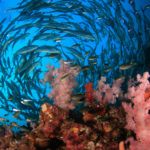
This small island is infamous for ripping currents — not just in one direction, but cross- directionally and strong down currents as well. One of our group — an experienced instructor — was pulled down from 40 feet (12 m) to 80 feet (24 m) fast. At the half-moon each month and during slack tides, Tatawa Kecil suitable for all divers; at other times only extremely-experienced divers should attempt a dive here. The site has healthy hard corals, reef sharks, large trevallies, and tunas. A cave at 80 feet (24 m) features pygmy seahorses and on the northern side at 75 feet (22 m) there’s a cleaning station used by sweetlips. In season mantas also frequent this area.
Batu Bolong
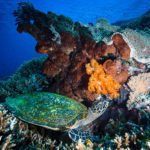
Batu Bolong is a classic dive Komodo dive and rightly world famous. From the surface it’s an unassuming small rock, but underneath is a vibrant pinnacle with a north and south face. You’ll usually only dive one side at a time due to the currents, though at slack tides you might be able to spiral the pinnacle. The dive usually starts at 80 to 100 feet (24 to 30 m), and you’ll ascend zig-zag fashion back and forth across the healthy and colorful reef, turning to avoid the current.
Healthy soft and hard corals cover the pinnacle and there’s great macro life as well, including seahorses and nudibranchs. Giant tuna, Napoleon wrasse, reef sharks and hawksbill turtles are common as well. The shallows feature beautiful plate and branching coral formations and hundreds of schooling fish. From the surface you can often see the water ‘boiling’ like in a jacuzzi due to the currents and your operator may choose to cancel or reschedule the dive.
Cauldron/Shotgun
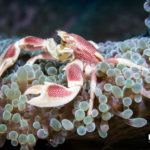
This is another Komodo classic thanks to the exhilarating current that rockets divers through part of the dive site. The site sits in a channel between two islands in the north of Komodo’s marine park. You’ll begin on a coral reef and move with the current into a sandy bowl, called the cauldron, at about 60 to 75 feet (18 to 20 m). From here the current intensifies as you move into “the shotgun,” flying up a steep wall and through a break in the reef. If possible, you can use a reef hook here to look back into the cauldron, but at times the current is just too strong. Enjoy the ride, where you might see mantas, schooling fish and barracuda as you glide past. The current will deposit you and your dive group onto another section of the reef with vibrant marine life, healthy corals, and great macro creatures.
Manta Alley/Point
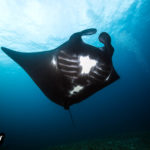
As the name suggests, mantas are common here from September to January, although off-season encounters are possible as well. In peak months, divers often report up to 20 mantas, circling and swimming around on the dive. It’s a drift dive and currents can be strong, with a maximum depth of around 40 to 50 feet (12 to 15 m). Reef hooks or pointers are best for stopping to observe the mantas. The site also features healthy coral bommies, schooling fusiliers, triggerfish, wrasse, and reef sharks.
Castle Rock
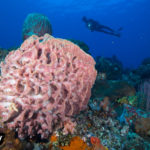
Castle Rock is one of the largest seamounts in the park and another Komodo highlight. The bottom is around 100 feet (30 m) and rises to 15 feet (5 m), which makes for fantastic safety stops. The currents here are usually mild to strong and visibility is generally quite good. The seamount is a haven for fish such as grouper and wrasse, along with sharks and the occasional dolphin. Expect healthy corals and plentiful macro life as well.
The post Top Five Dive Sites in Komodo appeared first on Scuba Diver Life.
from Scuba Diver Life https://ift.tt/2Lut1V4
No comments:
Post a Comment